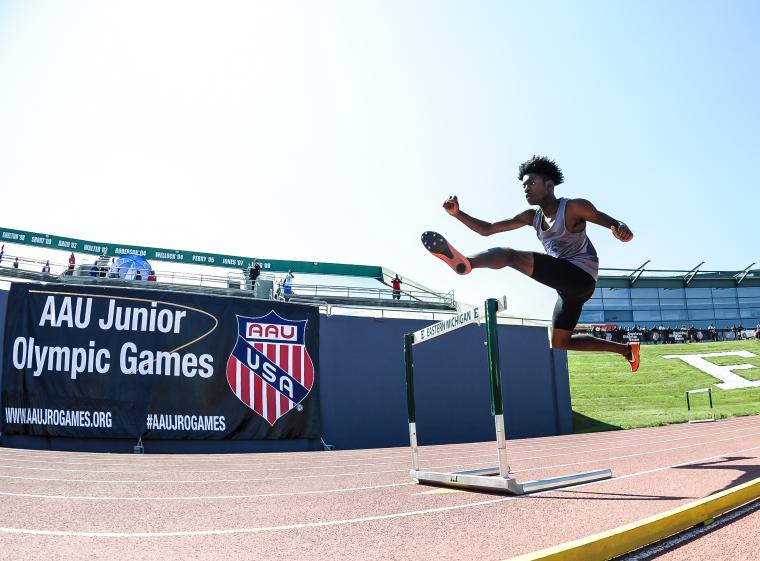
All photos courtesy of the AAU
The AAU Junior Olympic Games, presented each summer in rotating locations, brings in more than 19,000 total participants (ages 8-18) across 12 sports, with 14,000 of those competing in track and field alone. The economic impact is estimated at $65 million. SDM caught up with the AAU’s Rusty Buchanan to learn more about this great event and what it offers to its athletes, their families and to hosting communities.
 Sports Destination Mamagement: According to the AAU website, the AAU Junior Olympic Games were first held in 1967 with 523 athletes. It sure has grown!
Sports Destination Mamagement: According to the AAU website, the AAU Junior Olympic Games were first held in 1967 with 523 athletes. It sure has grown!
Rusty Buchanan: Yes, it’s even bigger than the Olympics, and we have a ton of great alumni. Jesse Owens, for example, was an AAU athlete. And last year, one pole vault athlete, Isaiah Whittaker, jumped 16’2” and broke the meet, American and world records for his age group.
SDM: Wow – so the Junior Olympic Games is a showcase for elite athletes?
Buchanan: It’s an event for the kids who want to participate in it. Track & field athletes need to qualify for the event at the national level by participating in a regional qualifier but in some of the other sports, that is not necessary. By the way, track & field is the biggest event, but swimming is the second-biggest.
Note: A full list of sports offered this past summer when the Games came to Greensboro, North Carolina can be found here.
SDM: Does the line-up of sports change or is it set?
Buchanan: There are new sports each year and the Games themselves have a slightly different reach depending on the hosting city. We still have the core of the big sports we know will bring solid participation.
SDM: The Games will be in Des Moines in 2023; Greensboro in 2024; Houston in 2025; Des Moines in 2026; Houston in 2027; Baltimore in 2028; Greensboro in 2029; Des Moines in 2030; Baltimore in 2032 and Greensboro in 2033. What do you look for when it comes to finding a host city?
 Buchanan: The number-one priority, first and foremost, is the willingness of the city to participate in this, someone who will really be a partner, not just someone who is looking for economic impact. We want a city where people are truly willing to roll up their sleeves. A city needs to really desire to be a part of this.
Buchanan: The number-one priority, first and foremost, is the willingness of the city to participate in this, someone who will really be a partner, not just someone who is looking for economic impact. We want a city where people are truly willing to roll up their sleeves. A city needs to really desire to be a part of this.
After that, we look at the infrastructure. We need to know they have the right venues, including a track with a stadium that will seat 15,000 people because on the dates that we are doing races, those are running literally every 20 seconds.
We also need to make sure they have appropriate transportation and the ability to handle the logistical issues. You’re going to have people coming in from all 50 states, and the city needs to be accessible enough for people to get there.
SDM: We know you’re bid out through 2033; how should cities contact you if they are interested in hosting in the future?
Buchanan: They can request information from our office; people are more than welcome to do that.
 SDM: It’s easy to see why all those pieces would need to be in place – it’s a big undertaking.
SDM: It’s easy to see why all those pieces would need to be in place – it’s a big undertaking.
Buchanan: The event starts with some of our indoor sports like karate, gymnastics and taekwondo. We build in time specifically for track & field, and we do the schedule with the goal of being finished by 4 each day so that if the meet is delayed for any reason, we have time to adjust the schedule and run into the evening.
SDM: Do you feel like AAU has fully recovered from the pandemic?
Buchanan: Yes, definitely. We just had our largest total membership year ever; we surpassed the old record by over 40,000 members. Kids need to be AAU members to compete in our events. By the way, we also run background checks on all non-youth adult participants.
SDM: AAU also has destinations that offer other championships. The AAU Junior Volleyball Nationals is one event that comes to mind.
Buchanan: Yes, and that is a great example. More than 4,550 teams come to that event. It’s hard to explain how big it is and how it just keeps growing. But we offer so many other events and they don’t always have to be traditional. For example, we host a beach volleyball event in California every year and it has turned into one of the largest in the country. We encourage destinations to invest in themselves and to create events.
 SDM: And beach volleyball is a great opportunity because it is really growing.
SDM: And beach volleyball is a great opportunity because it is really growing.
Buchanan: It’s also a great opportunity for the kids. One of our AAU girls teams from that event went on to win the world championship for International School Sports Federation in Normandy France.

